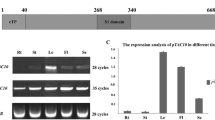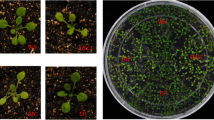Abstract
Main conclusion
The extreme Alb3 C terminus is important for Alb3 stability in a light dependent manner, but is dispensable for LHCP insertion or D1 synthesis.
YidC/Oxa1/Alb3 dependent insertion of membrane proteins is evolutionary conserved among bacteria, mitochondria and chloroplasts. Chloroplasts are challenged by the need to coordinate membrane integration of nuclear encoded, post-translationally targeted proteins into the thylakoids as well as of proteins translated on plastid ribosomes. The pathway facilitating post-translational targeting of the light-harvesting chlorophyll a/b binding proteins involves the chloroplast signal recognition particle, cpSRP54 and cpSRP43, as well as its membrane receptor FtsY and the translocase Alb3. Interaction of cpSRP43 with Alb3 is mediated by the positively charged, stromal exposed C terminus of Alb3. In this study, we utilized an Alb3 T-DNA insertion mutant in Arabidopsis thaliana lacking the last 75 amino acids to elucidate the function of this domain (alb3∆C). However, the truncated Alb3 protein (Alb3∆C) proved to be unstable under standard growth conditions, resulting in a reduction of Alb3∆C to 20 % of wild-type levels. In contrast, accumulation of Alb3∆C was comparable to wild type under low light growth conditions. Alb3∆C mutants grown under low light conditions were only slightly paler than wild type, accumulated almost wild-type levels of light harvesting proteins and were not affected in D1 synthesis, therefore showing that the extreme Alb3 C terminus is dispensable for both, co- and post-translational, protein insertion into the thylakoid membrane. However, reduction of Alb3∆C levels as observed under standard growth conditions resulted not only in a severely diminished accumulation of all thylakoid complexes but also in a strong defect in D1 synthesis and membrane insertion.






Similar content being viewed by others
References
Arnon DJ (1949) Copper enzymes in isolated chloroplasts. Polyphenoloxidase in Beta vulgaris. Plant Physiol 24:1–15
Bals T, Dunschede B, Funke S, Schunemann D (2010) Interplay between the cpSRP pathway components, the substrate LHCP and the translocase Alb3: an in vivo and in vitro study. FEBS Lett 584:4138–4144
Bellafiore S, Ferris P, Naver H, Gohre V, Rochaix JD (2002) Loss of Albino3 leads to the specific depletion of the light-harvesting system. Plant Cell 14:2303–2314
Benz M, Bals T, Gugel IL, Piotrowski M, Kuhn A, Schunemann D, Soll J, Ankele E (2009) Alb4 of Arabidopsis promotes assembly and stabilization of a non chlorophyll-binding photosynthetic complex, the CF1CF0-ATP synthase. Mol Plant 2:1410–1424
Cai W, Ma J, Chi W, Zou M, Guo J, Lu C, Zhang L (2010) Cooperation of LPA3 and LPA2 is essential for photosystem II assembly in Arabidopsis. Plant Physiol 154:109–120
Chidgey JW, Linhartova M, Komenda J, Jackson PJ, Dickman MJ, Canniffe DP, Konik P, Pilny J, Hunter CN, Sobotka R (2014) A cyanobacterial chlorophyll synthase-HliD complex associates with the Ycf39 protein and the YidC/Alb3 insertase. Plant Cell 26:1267–1279
Clough SJ, Bent AF (1998) Floral dip: a simplified method for Agrobacterium-mediated transformation of Arabidopsis thaliana. Plant J 16:735–743
Czarnecki O, Grimm B (2012) Post-translational control of tetrapyrrole biosynthesis in plants, algae, and cyanobacteria. J Exp Bot 63:1675–1687
Czarnecki O, Hedtke B, Melzer M, Rothbart M, Richter A, Schroter Y, Pfannschmidt T, Grimm B (2011) An Arabidopsis GluTR binding protein mediates spatial separation of 5-aminolevulinic acid synthesis in chloroplasts. Plant Cell 23:4476–4491
Dalbey RE, Kuhn A, Zhu L, Kiefer D (2014) The membrane insertase YidC. Biochim Biophys Acta 1843:1489–1496
Dunschede B, Bals T, Funke S, Schunemann D (2011) Interaction studies between the chloroplast signal recognition particle subunit cpSRP43 and the full-length translocase Alb3 reveal a membrane-embedded binding region in Alb3 protein. J Biol Chem 286:35187–35195
Falk S, Sinning I (2010) The C terminus of Alb3 interacts with the chromodomains 2 and 3 of cpSRP43. J Biol Chem 285:le25–le26 (author reply le26–28)
Falk S, Ravaud S, Koch J, Sinning I (2010) The C terminus of the Alb3 membrane insertase recruits cpSRP43 to the thylakoid membrane. J Biol Chem 285:5954–5962
Gohre V, Ossenbuhl F, Crevecoeur M, Eichacker LA, Rochaix JD (2006) One of two alb3 proteins is essential for the assembly of the photosystems and for cell survival in Chlamydomonas. Plant Cell 18:1454–1466
Granvogl B, Reisinger V, Eichacker LA (2006) Mapping the proteome of thylakoid membranes by de novo sequencing of intermembrane peptide domains. Proteomics 6:3681–3695
Jarvi S, Suorsa M, Aro EM (2015) Photosystem II repair in plant chloroplasts—regulation, assisting proteins and shared components with photosystem II biogenesis. Biochim Biophys Acta. doi:10.1016/j.bbabio.2015.01.006
Jia L, Dienhart M, Schramp M, McCauley M, Hell K, Stuart RA (2003) Yeast Oxa1 interacts with mitochondrial ribosomes: the importance of the C-terminal region of Oxa1. EMBO J 22:6438–6447
Jiang F, Yi L, Moore M, Chen M, Rohl T, Van Wijk KJ, De Gier JW, Henry R, Dalbey RE (2002) Chloroplast YidC homolog Albino3 can functionally complement the bacterial YidC depletion strain and promote membrane insertion of both bacterial and chloroplast thylakoid proteins. J Biol Chem 277:19281–19288
Klostermann E, Droste Gen Helling I, Carde JP, Schunemann D (2002) The thylakoid membrane protein ALB3 associates with the cpSecY-translocase in Arabidopsis thaliana. Biochem J 368:777–781
Kovacs-Bogdan E, Benz JP, Soll J, Bolter B (2011) Tic20 forms a channel independent of Tic110 in chloroplasts. BMC Plant Biol 11:133
Kumazaki K, Chiba S, Takemoto M, Furukawa A, Nishiyama K, Sugano Y, Mori T, Dohmae N, Hirata K, Nakada-Nakura Y, Maturana AD, Tanaka Y, Mori H, Sugita Y, Arisaka F, Ito K, Ishitani R, Tsukazaki T, Nureki O (2014) Structural basis of Sec-independent membrane protein insertion by YidC. Nature 509:516–520
Lewis NE, Marty NJ, Kathir KM, Rajalingam D, Kight AD, Daily A, Kumar TK, Henry RL, Goforth RL (2010) A dynamic cpSRP43-Albino3 interaction mediates translocase regulation of chloroplast signal recognition particle (cpSRP)-targeting components. J Biol Chem 285:34220–34230
Ma J, Peng L, Guo J, Lu Q, Lu C, Zhang L (2007) LPA2 is required for efficient assembly of photosystem II in Arabidopsis thaliana. Plant Cell 19:1980–1993
Meurer J, Plucken H, Kowallik KV, Westhoff P (1998) A nuclear-encoded protein of prokaryotic origin is essential for the stability of photosystem II in Arabidopsis thaliana. EMBO J 17:5286–5297
Moore M, Harrison MS, Peterson EC, Henry R (2000) Chloroplast Oxa1p homolog albino3 is required for post-translational integration of the light harvesting chlorophyll-binding protein into thylakoid membranes. J Biol Chem 275:1529–1532
Moore M, Goforth RL, Mori H, Henry R (2003) Functional interaction of chloroplast SRP/FtsY with the ALB3 translocase in thylakoids: substrate not required. J Cell Biol 162:1245–1254
Mulo P, Sirpio S, Suorsa M, Aro EM (2008) Auxiliary proteins involved in the assembly and sustenance of photosystem II. Photosynth Res 98:489–501
Nickelsen J, Rengstl B (2013) Photosystem II assembly: from cyanobacteria to plants. Annu Rev Plant Biol 64:609–635
Ossenbuhl F, Gohre V, Meurer J, Krieger-Liszkay A, Rochaix JD, Eichacker LA (2004) Efficient assembly of photosystem II in Chlamydomonas reinhardtii requires Alb3.1p, a homolog of Arabidopsis ALBINO3. Plant Cell 16:1790–1800
Ossenbuhl F, Inaba-Sulpice M, Meurer J, Soll J, Eichacker LA (2006) The synechocystis sp PCC 6803 oxa1 homolog is essential for membrane integration of reaction center precursor protein pD1. Plant Cell 18:2236–2246
Pasch JC, Nickelsen J, Schunemann D (2005) The yeast split-ubiquitin system to study chloroplast membrane protein interactions. Appl Microbiol Biotechnol 69:440–447
Porra RJ, Thompson WA, Kriedemann PE (1989) Determination of accurate extinction coefficientsand simultaneous equations for assaying chlorophylls a and b extracted with four different solvents: verification of the concentration of chlorophyll standards by atomic absorption spectroscopy. Biochim Biophys Acta 975:384–394
Reynolds ES (1963) The use of lead citrate at high pH as an electron opaque stain in electron microscopy. J Cell Biol 17:208
Saaf A, Monne M, de Gier JW, von Heijne G (1998) Membrane topology of the 60-kDa Oxa1p homologue from Escherichia coli. J Biol Chem 273:30415–30418
Saller MJ, Wu ZC, de Keyzer J, Driessen AJ (2012) The YidC/Oxa1/Alb3 protein family: common principles and distinct features. Biol Chem 393:1279–1290
Schneider A, Steinberger I, Strissel H, Kunz HH, Manavski N, Meurer J, Burkhard G, Jarzombski S, Schunemann D, Geimer S, Flugge UI, Leister D (2014) The Arabidopsis Tellurite resistance C protein together with ALB3 is involved in photosystem II protein synthesis. Plant J 78:344–356
Schonberg A, Bergner E, Helm S, Agne B, Dunschede B, Schunemann D, Schutkowski M, Baginsky S (2014) The peptide microarray “ChloroPhos1.0” identifies new phosphorylation targets of plastid casein kinase II (pCKII) in Arabidopsis thaliana. PLoS One 9:e108344
Schuenemann D, Gupta S, Persello-Cartieaux F, Klimyuk VI, Jones JD, Nussaume L, Hoffman NE (1998) A novel signal recognition particle targets light-harvesting proteins to the thylakoid membranes. Proc Natl Acad Sci USA 95:10312–10316
Schwenkert S, Umate P, Dal Bosco C, Volz S, Mlcochova L, Zoryan M, Eichacker LA, Ohad I, Herrmann RG, Meurer J (2006) PsbI affects the stability, function, and phosphorylation patterns of photosystem II assemblies in tobacco. J Biol Chem 281:34227–34238
Spence E, Bailey S, Nenninger A, Moller SG, Robinson C (2004) A homolog of Albino3/OxaI is essential for thylakoid biogenesis in the cyanobacterium Synechocystis sp. PCC6803. J Biol Chem 279:55792–55800
Spurr AR (1969) A low-viscosity epoxy resin embedding medium for electron microscopy. J Ultrastruct Res 26:31–43
Stengel KF, Holdermann I, Cain P, Robinson C, Wild K, Sinning I (2008) Structural basis for specific substrate recognition by the chloroplast signal recognition particle protein cpSRP43. Science 321:253–256
Sundberg E, Slagter JG, Fridborg I, Cleary SP, Robinson C, Coupland G (1997) ALBINO3, an Arabidopsis nuclear gene essential for chloroplast differentiation, encodes a chloroplast protein that shows homology to proteins present in bacterial membranes and yeast mitochondria. Plant Cell 9:717–730
Szyrach G, Ott M, Bonnefoy N, Neupert W, Herrmann JM (2003) Ribosome binding to the Oxa1 complex facilitates co-translational protein insertion in mitochondria. EMBO J 22:6448–6457
Wada M (2013) Chloroplast movement. Plant Sci 210:177–182
Walter B, Hristou A, Nowaczyk MM, Schunemann D (2015) In vitro reconstitution of cotranslational D1 insertion reveals a role of the cpSec/Alb3 translocase and Vipp1 in photosystem II biogenesis. Biochem J 468(2):315–324. doi:10.1042/BJ20141425
Wang P, Dalbey RE (2011) Inserting membrane proteins: the YidC/Oxa1/Alb3 machinery in bacteria, mitochondria, and chloroplasts. Biochim Biophys Acta 1808:866–875
Woolhead CA, Thompson SJ, Moore M, Tissier C, Mant A, Rodger A, Henry R, Robinson C (2001) Distinct Albino3-dependent and -independent pathways for thylakoid membrane protein insertion. J Biol Chem 276:40841–40846
Zhao A, Fang Y, Chen X, Zhao S, Dong W, Lin Y, Gong W, Liu L (2014) Crystal structure of Arabidopsis glutamyl-tRNA reductase in complex with its stimulator protein. Proc Natl Acad Sci USA 111:6630–6635
Acknowledgments
Michaela Häusler is greatly acknowledged for excellent technical assistance. We would further like to thank Ralph Krafczyk for help with genotyping experiments. Alb3 antisera were a kind gift from Danja Schünemann as well as HCF136 antisera from Peter Westhoff. ATP synthase antisera were kindly provided by Stephan Greiner. Financial support from the German Research Council (DFG, SFB1035, project A4, to JS., SS), the Munich Center for Integrated Protein Science (CiPSM, Exc114/2) to JS, BB and SS, as well as the Academy of Finland Centre of Excellence in Molecular Biology of Primary Producers 271832 to PM and MK and the DFG Research Unit FOR2092 (Gr936 18-1) to BG is acknowledged.
Author information
Authors and Affiliations
Corresponding author
Additional information
M. Urbischek and S. Nick von Braun have contributed equally.
Rights and permissions
About this article
Cite this article
Urbischek, M., Nick von Braun, S., Brylok, T. et al. The extreme Albino3 (Alb3) C terminus is required for Alb3 stability and function in Arabidopsis thaliana . Planta 242, 733–746 (2015). https://doi.org/10.1007/s00425-015-2352-y
Received:
Accepted:
Published:
Issue Date:
DOI: https://doi.org/10.1007/s00425-015-2352-y




